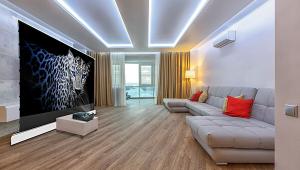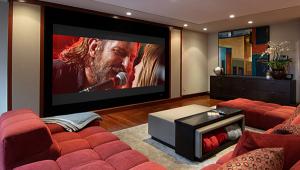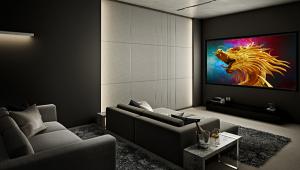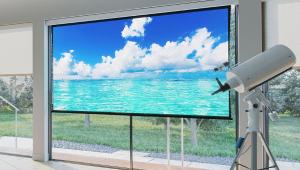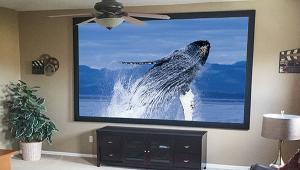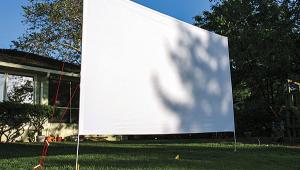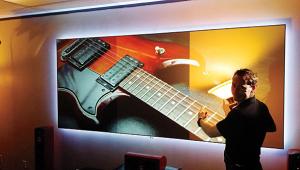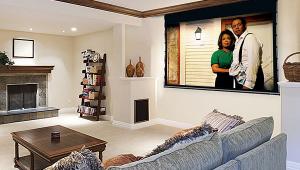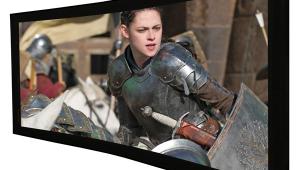Carada Masquerade Page 2
Another option that is becoming increasingly popular in the front projection world is a 2.35:1 constant-height setup. Rather than the popular 16:9 standard HDTV screen, you use a wider 2.35:1 screen. In order to use this kind of setup properly, you usually need an anamorphic lens and some kind of video processing. The video processor stretches the image to eliminate the black bars, and then an anamorphic lens unstretches it for proper presentation on a 2.35:1 screen. (You can read more about this on page 50.) When you watch a film with an aspect ratio that’s narrower than 2.35:1, there will be black bars on the sides of the image that you can easily mask with curtains or a masking system. (Carada is developing another version of the Masquerade for this type of application.) This venture can be expensive, and it includes a lot of variables. The addition of a second lens in the light path can cause side effects, and extra video processing can produce mixed results. In this case, the display uses all of its vertical pixels to display the image, which is also larger. Executed properly, this method offers undeniable advantages. I’ve seen it produce outstanding image quality. But it takes a sizeable investment that most people can’t afford.
The last option, and the one I’m focusing on here, is masking. Masking has become more and more popular with screen manufacturers, but it can also be on the expensive side. Most screens include a small frame that anchors the screen material. Some manufacturers offer motorized masking panels that eliminate the black bars associated with various aspect ratios. These solutions typically raise the screen price considerably. But since Carada’s system works with your existing screen, and because the company offers its products Internet-direct, the Masquerade masking system changes that. A Masquerade system for a 100-inch-diagonal screen (the most popular size on the market) retails for about $2,500. Although this isn’t cheap for an accessory, it’s considerably cheaper than a masking system with comparable features from a screen company. Once you see what this type of system can do for your home theater, you’ll find out what a bargain this really is.
In Use
During my evaluation, I used the Masquerade with three different projectors: the Planar PD8150, the BenQ W20000, and the JVC DLA-RS2. This allowed me to test the masking system with a variety of contrast ratios to see how much benefit this solution could provide. I was surprised at how well the Masquerade increased the perceived depth and contrast with these projectors. During my tests, I viewed a lot of mixed-contrast program material (material with very bright and very dark elements on screen simultaneously). This material showed a lot more pop and dimensionality when I used the masking. Even my wife, who was extremely skeptical about the system, was floored by how much the masking changed the image perception. When the Masquerade eliminated the negative space around the image, it livened up the image and anchored the blacks. My wife couldn’t help but comment about the Masquerade’s “cool factor.” The system adds to the cinema feel when you engage the masks and see them change your screen’s effective aspect ratio like you see in theaters.
When I moved on to the JVC DLA-RS2 projector, I started to wonder how much the masking would help. The DLA-RS2 already has incredible black levels, including the black bars. It didn’t seem to need much help from the Masquerade. But when I used the Masquerade, I definitely saw a difference. The image looked a bit brighter when I saw it displayed directly against a true black background. I also saw an increase in the perceived contrast in those mixed-contrast scenes. LCOS projectors don’t often provide the high contrast that DLP projectors exhibit with this kind of material. But the DLA-RS2’s dimension and pop in mixed scenes looked as good as (if not better than) the DLPs I used with the same mask. Remember, displays do a better job with perceived contrast when there is mixed material on the screen and less black area.
The only place I didn’t see a marked improvement with the masking system was pure blackouts. Let’s be frank, nothing but a substantially better on/off contrast ratio will significantly help in this department. You can improve blackouts a bit if you eliminate stray light in your home theater, but masking will not make a pure black image look blacker. Since black velvet already frames my screen, the masking system does nothing to enhance this experience more than what I already have. But I expected this.
Conclusion
Rarely do I see an accessory that significantly impacts the video side of home theater. But this product is definitely one of them. It costs less than a standard masking system, and you can use it with most popular fixed-frame screens on the market (check with Carada for compatibility). This makes it a rare standout in price and performance. If you want to make the most of your front-projection system and you can’t afford a constant-height setup, put Carada’s Masquerade on your short list.
- Log in or register to post comments
